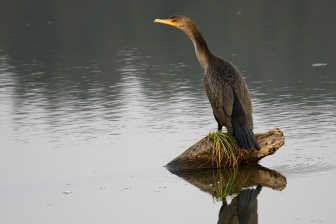forum
library
tutorial
contact

Corps Avian Hazing at Lower Snake Dams
Now Includes Lethal 'Take' of Gulls, Cormorants
by Staff
Columbia Basin Bulletin, April 4, 2014
|
the film forum library tutorial contact |

|
Corps Avian Hazing at Lower Snake Dams
by Staff
|
 To provide further protections for threatened and endangered salmon and steelhead, the U.S. Army Corps of Engineers' Walla Walla District is expanding its current nonlethal avian hazing program at five Corps dams to incorporate limited lethal "take" of certain piscivorous -- fish-eating -- birds.
To provide further protections for threatened and endangered salmon and steelhead, the U.S. Army Corps of Engineers' Walla Walla District is expanding its current nonlethal avian hazing program at five Corps dams to incorporate limited lethal "take" of certain piscivorous -- fish-eating -- birds.
The Corps' expanded program will allow removal of a maximum total of 650 ring-billed gulls, 1,200 California gulls and 150 double-crested cormorants each year at the five dams.
The Corps worked with other agencies to complete required environmental reviews for the expanded program. As part of its decision-making process, the Corps adopted the U.S. Department of Agriculture Wildlife Services' 2011 environmental assessment - "Bird Damage Management in Washington," and signed a finding of no significant impact on March 17. The EA and FONSI, part of National Environmental Policy Act responsibilities of the federal agencies, are available on the Walla Walla District website at: www.nww.usace.army.mil/Missions/Projects/ExpandedBirdDeterrence.aspx.
Any lethal take of avian predators will be in response to particular situations such as when aggregations of birds are focused on particular fish delay points or bottlenecks and are not dissuaded by non-lethal hazing.
The Corps has determined these expanded efforts will not significantly impact distribution, abundance, or population trends of these bird species.
This expanded effort is in conjunction with the Corps' existing nonlethal hazing program to manage piscivorous birds, which uses pyrotechnics and other noisemaking devices, water-spray cannons, and passive deterrent structures at the dames to dissuade birds from preying on juvenile salmon and steelhead as they migrate downstream toward the Pacific Ocean, according to a March 27 Walla Walla District press release. The migrating fish include Snake River fall and spring/summer chinook salmon, sockeye salmon and steelhead, as well as Upper Columbia spring chinook salmon and steelhead, that are listed under the federal Endangered Species Act.
The birds prey on young fish up and down the river, but also seem to focus efforts at dams where the salmon and steelhead are siphoned through mechanical bypass systems and turbines and over spill ways. The Corps predation reduction efforts will target certain areas at Corps dams where the avian predators feast on salmonids.
Lethal removal will be used only if nonlethal methods are not successful.
"Preference is given to practical and effective nonlethal methods when determining the damage management strategy," according to a Corps evaluation prepared as part of the NEPA process. "However, not all nonlethal methods are practical and effective for every damage situation. The current program employs methods specific to the risk/level of damage being caused and species involved. Operations under this alternative are directed at alleviating damage and not intended to control populations of any native species."
"The Corps has focused primarily on non-lethal measures such as hazing and bird wires in an attempt to deter avian predation on salmon ids. However, it is apparent that nonlethal methods do not suffice as the number of salmonids taken by piscivorous birds is believed to be increasing. Therefore, the Corps has determined that expanded measures such as limited lethal take now need to be implemented," the evaluation says.
Seasonal avian hazing by U.S. Department of Agriculture (USDA) Wildlife Services (WS) personnel was scheduled to begin March 30 at McNary Lock and Dam near Umatilla, Ore., and April 1 in Washington state on the Lower Snake River at Ice Harbor Lock and Dam; Lower Monumental Lock and Dam; Little Goose Lock and Dam; and Lower Granite Lock and Dam.
The 2008/2010 Federal Columbia River Power System biological opinion, as supplemented in 2014, in its "reasonable and prudent alternative," action 48, directs the Corps to "continue to implement and improve avian deterrent programs at all lower Snake and Columbia River dams."
The FCRPS RPA outlines a program to protect listed Columbia basin of salmon and steelhead species by adopting hydro system operations and configuration changes with the intent of reducing adverse effects, while at the same time, implementing habitat restoration actions in spawning and rearing habitat in upstream Columbia and Snake river tributaries and in migration and rearing habitat in the river's. Additional RPA actions aim to reduce predation and minimize the adverse effects of FCRPS-funded mitigation hatchery programs.
Research studies have shown that piscivorous birds consume significant numbers of juvenile salmonids at dams.
The major causes of mortality of migrating juvenile salmonids in the Columbia River basin were identified as passage through the turbines, total dissolved gas supersaturated water due to spill, migration delays, fish disease, and predation by birds and fishes in the reservoir, forebay, and tailrace.
"Hydroelectric dams act as bottlenecks for juvenile salmonid migration and can injure and disorient smolt, increasing their vulnerability to avian predators (ODFW 1998)," according to the Wildlife Services' 2011 EA. "Piscivorous birds aggregate below hydroelectric dams in spring and summer and feed on emigrating juvenile salmonids. Between 1998 and 2008, avian predators consumed between 4 percent and 21 percent of the juvenile salmonids migrating downriver annually (Muir et al.)
Warm-weather visitors to Corps dams and adjacent recreation areas may see or hear hazing activities or authorized firearms use by USDA Wildlife Services personnel to dissuade or remove selected piscivorous birds. Public safety is a priority, but noise is expected from time to time.
learn more on topics covered in the film
see the video
read the script
learn the songs
discussion forum
